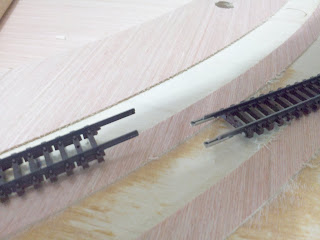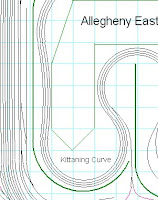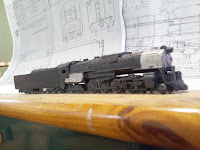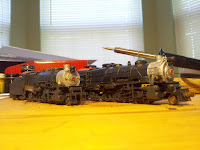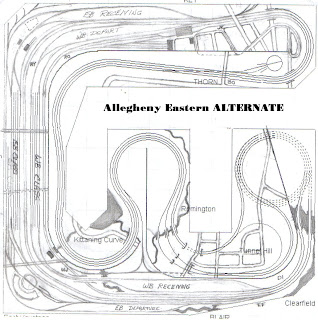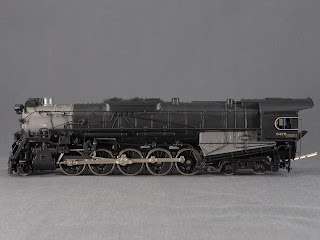I'm thinking that many of us take the time to research the prototype and period we want to model. We look at what locomotives were used, what cars carried the freight and passengers, and what the towns and cities looked like. We consult old maps and photos to get an idea what things looked like. We look at the buildings, the trees, the rocks, even the cars and trucks in the streets. We even learn what stop signs and street lights were being used. Yet there is one area I know I haven't researched at all.
The trains that run on the Allegheny Eastern will, for the most part, be made up of cars marked for the All East. All these cars will bear the logo, name and car number on the side. Most bulk commodity shipments, like coal, will be shipped on trains where every car will bear the name of the home road. What about other trains that carry mixed freight or even passengers. There are usually cars present marked for other industries, even other railroads.
I think you may see where this is going...If I am modeling a railroad as it was (or might have been) in the year 1949, I need to know what those other industries and railroads were doing in the same year. I would not run FP40's or intermodal cars marked Allegheny Eastern. Neither should I run a BNSF box car or a new Norfolk Southern coal hopper. These are extreme examples, of course, but you get the idea. I should find out what was running on the New York Central, Santa Fe, or Chicago & Illinois Midland in 1949.
I have several freight cars that I purchased because I liked them. There was no other reason. Most of them have paint schemes that struck my fancy. Others were gifts or included in lots that I bought of E-Bay or at a show. Here are some examples...
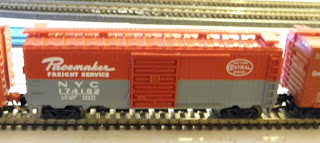 |
| New York Central "Pacemaker" |
The NYC offered overnight LCL (less then carload) service between New York City and Buffalo way back in 1935. It was interrupted by World War II and reintroduced in 1946 as Pacemaker. In 1948 the service was extended from Buffalo to Boston over the Boston & Albany, which was owned by the New York Central. A photo from 1946 shows a string of the specially painted cars behind a 4-8-4 Niagara.
 |
| 1946 New York Central "Pacemaker" Consist |
Unfortunately for me, the Pacemaker cars never left their home rails. It's doubtful that any of these cars would have shown up on Pennsy or any other property not controlled by New York Central. Each railroad had its own expedited merchandise service. The cars for this service on the Pennsylvania were primarily X41b and X29b class painted "boxcar red" with silver and white striping. A white PRR circle/keystone logo on a red background was prominently displayed along with the words "Merchandise Service" on the sides...
 |
| PRR Merchandise Service Boxcar |
Like the NYC the Pennsylvania kept its expediter fleet within it's own system. So it'd be OK to have an entire train of these cars on the mainline, but not the NYC or any other merchandise service. Cars assigned to All East Merchandise service would stay on the Allegheny Eastern providing overnight service between Philadelphia and Pittsburgh or perhaps Chicago. They would be painted for this specific purpose.
 |
| Allegheny Eastern "Expediter" |
Then there are those McGinnis colored cars from the New Haven and Boston & Maine. Were they around around in the late 40's? The answer is no. Patrick McGinnis served as president of the New Haven from 1954 to 1956. He moved on to the Boston & Maine in 1956. McGinnis colors should not appear on the Allegheny Eastern.
 |
| New Haven Boxcar in "Mc Ginnis" Paint |
The New York, Chicago & St Louis Railroad, commonly known as the Nickel Plate Road started using the High Speed Service livery on its caboose fleet in 1946. I'm not sure when the scheme was applied to boxcars, but for now I'll take it as the late 40's. This car would appear in All East mixed freights.
 |
| Nickle Plate "High Speed Service" |
The other consideration is what "technology" was available at the time. Some commodities, like grain, were shipped in boxcars. These were standard cars with "dams" placed across the doorways to hold the grain in. I don't think these cars were ever completely full. The load could have fit in a gondola, but since it needed to be covered during transit they used a boxcar. Covered hoppers for grain transport weren't in use yet.
 |
| Loading Grain Into a Milwaukee Road Boxcar |
Another example would be iron ore. On the Pennsylvania this ore was shipped in open hoppers, usually 50 ton GLa class. Because the ore was so heavy, the load was piled in each end of the car over the trucks. These cars were never fully loaded. On the Pennsy, cars specifically designed for carrying ore did not appear until much later.
 |
| Hulett Machine filling PRR Hoppers in Cleveland |
What about refrigerated cars for carrying produce and other perishables. Most of the reefers in 1949 still had ice bunkers. Powered refrigeration units were few in number. Icing stations were available at various points along the railroad to refresh the ice in the bunkers. Altoona was one of these places. Not only would reefers on the All East have roof hatches for the bunkers, there should be an ice house with sidings to service these cars.
 |
| Filling the Ice Bunker on a Reefer. |
Stock cars would be handled in a similar fashion. Federal law dictated that live stock had to be unloaded at regular intervals. Many major yards had sidings with stock pens just for this purpose. Because of it's location I don't think Altoona had stock pens, but on a model railroad you want as many excuses for switching as you can get. The yard at Llyswen should have stock pen facilities.
 |
| Stock Pens |
Foreign cars would also appear on a regular basis in passenger consists. Many railroads offered through service to cities they did not serve. It might have been possible to find Atlantic Coast Line or Seaboard cars mixed into PRR trains like the "Advance Florida Special" or the "Advance Silver Meteor".
 |
| Southern Pacific Sleeper "Glen Tarsan" |
Let's not forget the ubiquitous Pullman cars. These cars came in a variety of colors, some of them reflecting the railroads that leased them.
 |
| Pullman Sleepers "Glen Pond" and "Glen Blair" |
One final note...They were not "foreign" cars but the Pennsy had special heavyweight cars for shipping theater sets. These cars were named after plays, characters or authors like "Falstaff" or "Shakespeare".
 |
| PRR Class B70a Theatre Car "Shakespeare" |
There were also heavyweight cars to ship race horses from one track to another, another excuse to use those stock pens.
 |
| PRR Class B74b Racehorse Car |
I want to include some of these ideas into the trains on the Allegheny Eastern. It's one more way to create a convincing setting on my miniature rail empire.
Regards,
Frank Musick
Chief Cook & Bottle Washer
 |
| Allegheny Eastern Railroad |
